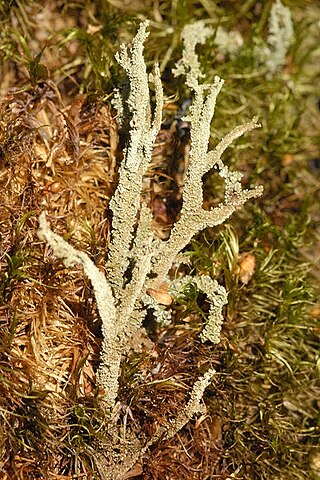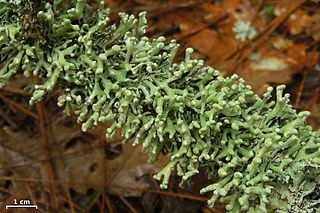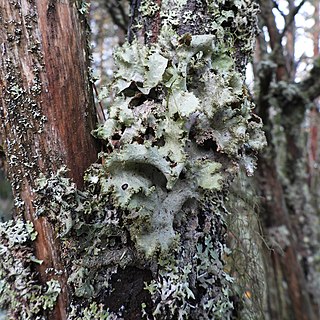Related Research Articles
Orsellinic acid, more specifically o-orsellinic acid, is a phenolic acid. It is of importance in the biochemistry of lichens, from which it can be extracted. It is a common subunit of depsides.

A depside is a type of polyphenolic compound composed of two or more monocyclic aromatic units linked by an ester group. Depsides are most often found in lichens, but have also been isolated from higher plants, including species of the Ericaceae, Lamiaceae, Papaveraceae and Myrtaceae.

Cetrelia is a genus of leafy lichens in the large family Parmeliaceae. They are commonly known as sea-storm lichens, alluding to the wavy appearance of their lobes. The name of the genus, circumscribed in 1968 by the husband and wife lichenologists William and Chicita Culberson, alludes to the former placement of these species in the genera Cetraria and Parmelia.

Niebla is a genus of yellow-green fruticose lichens that grow on rocks, trees, and shrubs within the fog zone of coastal North America, or more narrowly defined to occur on rocks and soil along the Pacific Coast from Mendocino County in California south to Baja California Sur.

Menegazzia terebrata is a species of foliose lichen found scattered across many continents, including North America, South America, Europe, Africa, and Asia.
A spot test in lichenology is a spot analysis used to help identify lichens. It is performed by placing a drop of a chemical on different parts of the lichen and noting the colour change associated with application of the chemical. The tests are routinely encountered in dichotomous keys for lichen species, and they take advantage of the wide array of lichen products produced by lichens and their uniqueness among taxa. As such, spot tests reveal the presence or absence of chemicals in various parts of a lichen. They were first proposed by the botanist William Nylander in 1866.

Depsidones are chemical compounds that are sometimes found as secondary metabolites in lichens. They are esters that are both depsides and cyclic ethers. An example is norstictic acid.

Umbilicaric acid is an organic polyphenolic carboxylic acid made by several species of lichen. It is named after Umbilicaria. Umbilicaric acid is a tridepside, containing three phenol rings.
Remototrachyna is a genus of foliose lichens in the large family Parmeliaceae. It was separated from the genus Hypotrachyna based on the structure of the excipulum and genetic differences.

Cladonia digitata, commonly known as the finger cup lichen, is a cup lichen species in the family Cladoniaceae.

Cladonia squamosa or the dragon cup lichen is a species of cup lichen in the family Cladoniaceae.

Atranorin is a chemical substance produced by some species of lichen. It is a secondary metabolite belonging to a group of compounds known as depsides. Atranorin has analgesic, anti-inflammatory, antibacterial, antifungal, cytotoxic, antioxidant, antiviral, and immunomodulatory properties. In rare cases, people can have an allergic reaction to atranorin.

Hypogymnia tubulosa is a species of foliose lichen in the family Parmeliaceae. Ludwig Emanuel Schaerer formally described it in 1840 as a variety of Parmelia ceratophylla. Johan Johnsen Havaas promoted it to distinct species status in 1918.

Salazinic acid is a depsidone with a lactone ring. It is found in some lichens, and is especially prevalent in Parmotrema and Bulbothrix, where its presence or absence is often used to help classify species in those genera.

Lichexanthone is an organic compound in the structural class of chemicals known as xanthones. Lichexanthone was first isolated and identified by Japanese chemists from a species of leafy lichen in the 1940s. The compound is known to occur in many lichens, and it is important in the taxonomy of species in several genera, such as Pertusaria and Pyxine. More than a dozen lichen species have a variation of the word lichexanthone incorporated as part of their binomial name. The presence of lichexanthone in lichens causes them to fluoresce a greenish-yellow colour under long-wavelength UV light; this feature is used to help identify some species. Lichexanthone is also found in several plants, and some species of fungi that do not form lichens.
Parmotrema lichexanthonicum is a species of foliose lichen in the family Parmeliaceae. Found in Brazil, it was formally described as a new species in 1997 by Sionara Eliasaro and Mónica Adler. The type specimen was collected by the first author from the Serra do Cipó ; here the lichen was found growing on a rock. The specific epithet lichexanthonicum refers to the presence of the secondary compound lichexanthone in the medulla of the lichen. Other compounds in the lichen are the depsidone salazinic acid, and the depside atranorin. A close relative to this species is Parmotrema ultralucens, which contains the same cortical and medullary metabolites.

Sekikaic acid is an organic compound in the structural class of chemicals known as depsides. It is found in some lichens. First isolated from Ramalina sekika, it is a fairly common lichen product in Ramalina and Cladonia, both genera of lichen-forming fungi. The species epithet of the powdery lichen Lepraria sekikaica refers to the presence of this substance—a rarity in genus Lepraria.

Barbatic acid is an organic compound that is made by some lichens. It is in the structural class known as depsides. It is particularly common in the genera Usnea and Cladonia.

Ramalina americana, commonly known as the sinewed ramalina, is a pale green fruticose lichen that is found across the Northern US Midwest, extending into Southern Canada and the Eastern Seaboard. It is characterized morphologically by the presence of pseudocyphellae, straight spores, and its unique chemical diversity.

Platismatia glauca is a common and widespread species of corticolous (bark-dwelling), foliose lichen in the family Parmeliaceae.
References
- ↑ Ranković & Kosanić 2019, p. 1.
- ↑ Molnár, Katalin; Farkas, Edit (2010). "Current Results on Biological Activities of Lichen Secondary Metabolites: a Review". Zeitschrift für Naturforschung C. 65 (3–4): 157–173. doi: 10.1515/znc-2010-3-401 . PMID 20469633.
- ↑ Stocker-Wörgötter, Elfie; Cordeiro, Lucimara Mach Cortes; Iacomini, Marcello (2013). "Accumulation of Potential Pharmaceutically Relevant Lichen Metabolites in Lichens and Cultured Lichen Symbionts". Studies in Natural Products Chemistry. Vol. 39. Elsevier. pp. 337–380. doi:10.1016/b978-0-444-62615-8.00010-2. ISBN 978-0-444-62615-8.
- ↑ Stocker-Wörgötter, Elfie (2008). "Metabolic diversity of lichen-forming ascomycetous fungi: culturing, polyketide and shikimatemetabolite production, and PKS genes". Natural Product Reports. 25 (1): 188–200. doi:10.1039/b606983p. PMID 18250902.
- ↑ Culberson, Chicita F.; Elix, john A. (1989). "Lichen Substances". Methods in Plant Biochemistry. Vol. 1. pp. 509–535. doi:10.1016/b978-0-12-461011-8.50021-4. ISBN 9780124610118.
- ↑ Ranković & Kosanić 2019, p. 4.
- ↑ Ranković & Kosanić 2019, p. 5.
- ↑ Culberson, Chicita F.; Culberson, William Louis (2001). "Future directions in lichen chemistry". The Bryologist. 104 (2): 230–234. doi:10.1639/0007-2745(2001)104[0230:FDILC]2.0.CO;2. JSTOR 3244888.
- ↑ Kalra, Rishu; Conlan, Xavier A.; Goel, Mayurika (2021). "Lichen allelopathy: a new hope for limiting chemical herbicide and pesticide use". Biocontrol Science and Technology. 31 (8): 773–796. doi:10.1080/09583157.2021.1901071.
- ↑ Culberson, Chicita F.; Kristinsson, Hör-Dur (1970). "A standardized method for the identification of lichen products". Journal of Chromatography A. 46: 85–93. doi:10.1016/s0021-9673(00)83967-9.
- ↑ Culberson, Chicita F. (1972). "Improved conditions and new data for identification of lichen products by standardized thin-layer chromatographic method". Journal of Chromatography A. 72 (1): 113–125. doi:10.1016/0021-9673(72)80013-x. PMID 5072880.
- ↑ Komaty, Sarah; Letertre, Marine; Dang, Huyen Duong; Jungnickel, Harald; Laux, Peter; Luch, Andreas; Carrié, Daniel; Merdrignac-Conanec, Odile; Bazureau, Jean-Pierre; Gauffre, Fabienne; Tomasi, Sophie; Paquin, Ludovic (2016). "Sample preparation for an optimized extraction of localized metabolites in lichens: Application to Pseudevernia furfuracea" (PDF). Talanta. 150: 525–530. doi:10.1016/j.talanta.2015.12.081. PMID 26838439.
- ↑ Studzinska-Sroka, Elzbieta; Galanty, Agnieszka; Bylka, Wieslawa (7 November 2017). "Atranorin - An Interesting Lichen Secondary Metabolite". Mini-Reviews in Medicinal Chemistry. 17 (17): 1633–1645. doi:10.2174/1389557517666170425105727. PMID 28443519.
- ↑ Jaeck, Andreas. "Atranorin". www.internetchemie.info.
- ↑ Cheng, Bichu; Trauner, Dirk (2015-11-04). "A Highly Convergent and Biomimetic Total Synthesis of Portentol". Journal of the American Chemical Society. 137 (43): 13800–13803. doi:10.1021/jacs.5b10009. ISSN 0002-7863. PMID 26471956.
- ↑ Candan, Mehmet; Yılmaz, Meral; Tay, Turgay; Erdem, Murat; Türk, Ayşen Özdemir (2007-08-01). "Antimicrobial Activity of Extracts of the Lichen Parmelia sulcata and its Salazinic Acid Constituent". Zeitschrift für Naturforschung C. 62 (7–8): 619–621. doi: 10.1515/znc-2007-7-827 . ISSN 1865-7125. PMID 17913083.
- ↑ Manojlović, Nedeljko; Ranković, Branislav; Kosanić, Marijana; Vasiljević, Perica; Stanojković, Tatjana (October 2012). "Chemical composition of three Parmelia lichens and antioxidant, antimicrobial and cytotoxic activities of some their major metabolites". Phytomedicine. 19 (13): 1166–1172. doi:10.1016/j.phymed.2012.07.012. PMID 22921748.
- ↑ "Wikispaces".
- ↑ Harris N. J. (1961), Honors Thesis, Clark University, Worcester, Massachusetts
- ↑ Lendemer, James C. (2011). "A taxonomic revision of the North American species of Lepraria s.l. that produce divaricatic acid, with notes on the type species of the genus L. incana". Mycologia. 103 (6): 1216–1229. doi:10.3852/11-032. PMID 21642343.
- ↑ Kukwa, Martin (2011). The lichen genus 'Ochrolechia' in Europe. Gdańsk; Sopot: Fundacja Rozwoju Uniwersytetu Gdańskiego. ISBN 978-83-7531-170-9.
- ↑ Stenroos, Soili (1989). "Taxonomy of the Cladonia coccifera group. 1". Annales Botanici Fennici. 26: 157–168.
- ↑ Timsina, Brinda A.; Hausner, Georg; Piercey-Normore, Michele D. (2014). "Evolution of ketosynthase domains of polyketide synthase genes in the Cladonia chlorophaea species complex (Cladoniaceae)". Fungal Biology. 118 (11): 896–909. doi:10.1016/j.funbio.2014.08.001. PMID 25442293.
- ↑ Lumbsch, H. Thorsten; Leavitt, Steven D. (2011). "Goodbye morphology? A paradigm shift in the delimitation of species in lichenized fungi". Fungal Diversity. 50 (1): 59–72. doi:10.1007/s13225-011-0123-z.
Cited literature
- Ranković, Branislav; Kosanić, Marijana (2019). "Lichens as a potential source of bioactive secondary metabolites". In Ranković, Branislav (ed.). Lichen Secondary Metabolites. Bioactive Properties and Pharmaceutical Potential (2 ed.). Springer Nature Switzerland AG. p. 13. ISBN 978-3-030-16813-1.